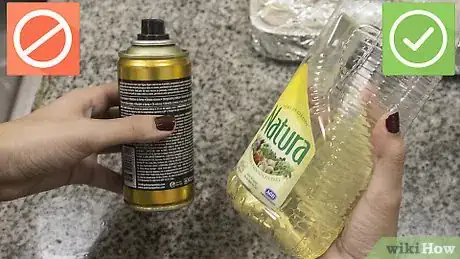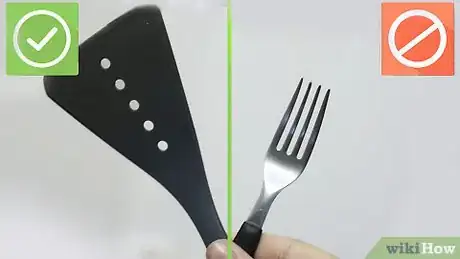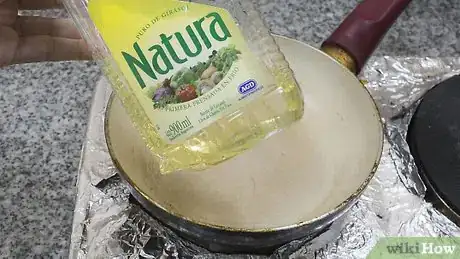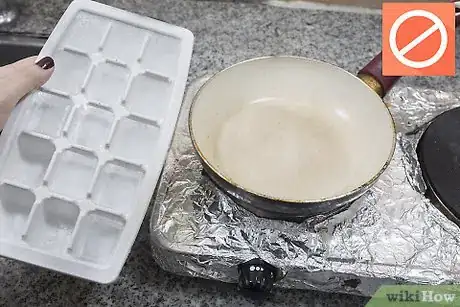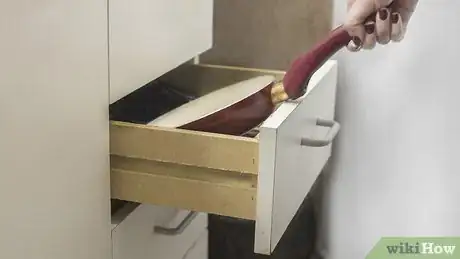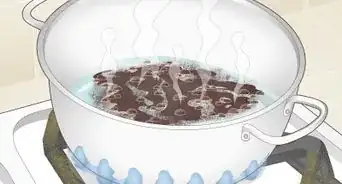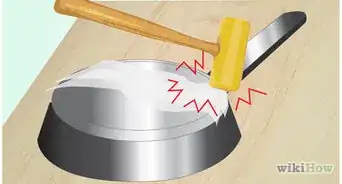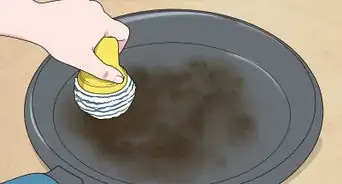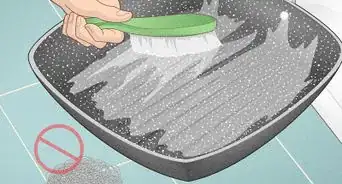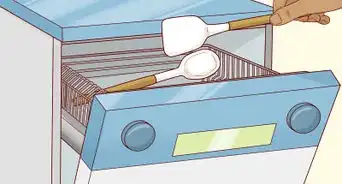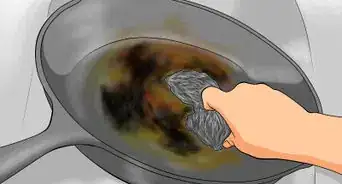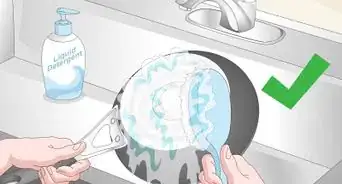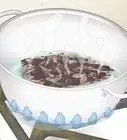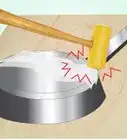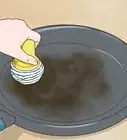This article was co-authored by James Sears. James Sears leads the customer happiness team at Neatly, a group of cleaning gurus based in Los Angeles and Orange County, California. James and the team have nine years of experience and offer green cleaning, interior and exterior window washing, and general apartment cleaning services. He provides transformative cleaning experiences by reducing clutter and renewing your home environment. James is a Trustee Scholar at the University of Southern California.
There are 8 references cited in this article, which can be found at the bottom of the page.
This article has been viewed 134,523 times.
Hand wash and hand dry your nonstick pan after each use to keep it clean and free of rust and residue. A simple baking soda paste can assist you with removing stubborn residue. Use your pan with care, for example by protecting it from high heat and abrasive objects. Nonstick pans have a special coating, so never scour your pan with abrasive sponges or harsh detergents.[1]
Steps
Washing and Drying Your Pan
-
1Wash your pan by hand after every use. Don’t wash your pan in the dishwasher, even if the manufacturer labels it as dishwasher-safe. Clean your pan with a mild, soft soap and a soft cloth or sponge. Rinse the pan with lukewarm, not hot, water.[2]
- To best remove dirt and grime, use a nylon or microfiber cloth or sponge.[3] You can find these at home goods stores or online.
- Dishwashing detergent and hot temperatures can shorten the life of your pan.[4]
- If you merely wipe the pan down with a towel instead of washing it, stuck-on residue can cook and stain during the next use of your pan.
-
2Soak the pan in warm, soapy water. Squirt about a teaspoon of dish soap into the pan. Place the pan into a stopped-up sink. Fill the sink with warm water. Let the pan soak for ten to twenty minutes, then hand wash it again.[5]
- Dish soap is made to remove bacteria as well as break up grease and residue.
Advertisement -
3Scrub stubborn gunk with a baking soda paste, if needed. Mix equal parts water and baking soda to form a paste. Dip a non-metallic brush or sponge into the paste, and gently dab it onto the sides and interior of the pan.[6] Allow the paste to sit for fifteen minutes. Rinse the pan thoroughly to remove the paste.
- Never use steel wool or any metallic sponge to scour your nonstick pan.
- Baking soda is abrasive, so don’t rub or scrub the pan with it.[7]
-
4Heat oil and salt in the pan. Pour two tablespoons of vegetable-based oil into the pan. Heat the pan over medium heat. Add three tablespoons of salt into the pan. Lift the pan from the heat and shake the pan until the oil and salt are evenly distributed. Once the pan has cooled, follow up with hand washing.
- Use sea salt, if you have it. If not, you can use table salt.
-
5Dry your pan immediately by hand. Don’t put your pan away while it’s still wet. Prevent rusting of your pan by ensuring that it’s completely dry before storing it. Use paper towels or a soft dish rag.[8]
Using Your Nonstick Pan
-
1Protect your pan from heat. Coat your cold pan evenly with butter, oil or fat before switching on the heat.[9] Don’t use high heat for cooking with your nonstick pan. Use low or medium heat.[10]
- A coating of fat both protects and aids the nonstick surface of your pan.
- High heat can ruin the surface of your pan, as well as potentially emit toxic fumes.
-
2Don’t use non-stick cooking sprays on your pan. Substitute this ingredient with oil, such as from an oil mister. Non-stick cooking sprays contain additives that build up on nonstick cookware, resulting in food that cooks unevenly.[11]
- The buildup from nonstick spray won’t burn off during the cooking process, and is difficult to remove.[12]
-
3Prevent metal and sharp objects from coming in contact with the pan. Use cooking utensils that won’t damage your nonstick pan.[13] Don’t use knives, metal cooking utensils, or steel wool on your pan.[14] Never cut your food while it’s still in the pan, or blend it with a metal whisk.[15]
- For example, use materials that won’t scratch your pan, such as plastic, nylon, silicone or wood.
Maintaining Your Nonstick Pan
-
1Season your pan with oil. Consult with the instructions that came with your pan to see how often, if at all, you should season your pan. Rinse and dry the pan completely. Rub a teaspoon of oil on the inside of the pan with a paper towel.[16] Put the pan in an oven preheated at 300°F (149°C) for one hour. Once the pan has cooled, wipe off the oil with paper towels.[17]
- If your pan has a nonstick coating, it may wear off with use over time. Seasoning your pan can make it last longer.
- For example, you may want to completely season your pan semiannually. Rub it with a small amount of oil every time before you use it.
-
2Don’t subject your pan to sudden temperature changes. Allow the pan to cool naturally after it’s been heated. Don’t run your pan under cold water while it’s hot, or vice versa.[18]
- Sudden temperature changes can cause nonstick cookware to warp, preventing heat from evenly distributing in the future.
-
3Store your pan with care. Hang your pans to store them, if possible, with decent space in between. If you must stack them, do so away from hard corners and sharp objects. Put a paper towel in between your pan and other cookware.[19]
- Padding your pan with a paper towel will help you to take the pan out without scraping it against other cookware.
Community Q&A
-
QuestionI have rust on a nonstick pan. How do I clean it?
 Joanne Kristine OlinaresCommunity AnswerPour isopropyl alcohol on the rust, heat it for a few minutes, then wipe with a dry cloth.
Joanne Kristine OlinaresCommunity AnswerPour isopropyl alcohol on the rust, heat it for a few minutes, then wipe with a dry cloth. -
QuestionMy sister boiled eggs in a pan and oxidized it. How do I clean it?
 Community AnswerPut a little bit of cream of tartar on a wet cloth and rub it over the surface, then massage the cream of tartar away with a soft-bristled brush.
Community AnswerPut a little bit of cream of tartar on a wet cloth and rub it over the surface, then massage the cream of tartar away with a soft-bristled brush. -
QuestionWhats the point in oiling a pan if it is suppose to be non-stick? Why have any pans that can emit toxic poison when subjected to high heat?
 FredwinaCommunity AnswerSome people believe that Teflon pans are toxic; a good alternative is ceramic pans that do not emit toxic fumes. As for the oils, I choose not to oil non-stick pans, especially if they are ceramic.
FredwinaCommunity AnswerSome people believe that Teflon pans are toxic; a good alternative is ceramic pans that do not emit toxic fumes. As for the oils, I choose not to oil non-stick pans, especially if they are ceramic.
wikiHow Video: How to Clean a Nonstick Pan
Warnings
- Avoid cooking acidic ingredients in your pan. Depending on the quality of the pan, acidic foods such as lemons and tomatoes can deteriorate the nonstick coating.[23]⧼thumbs_response⧽
- Replace your pan if you notice pits or peeling on the surface.[24]⧼thumbs_response⧽
- Never put your nonstick pan under a broiler.⧼thumbs_response⧽
- Don’t use ketchup or vinegar to clean your nonstick pan. Both are acidic and can damage the nonstick coating.[25]⧼thumbs_response⧽
- Unless the pan's instructions say it's safe to, never wash your nonstick pan in a dishwasher.[26]⧼thumbs_response⧽
References
- ↑ James Sears. House Cleaning Professional. Expert Interview. 28 August 2019.
- ↑ https://delishably.com/cooking-equipment/How-to-Take-Care-of-Your-Non-Stick-Frying-Pan
- ↑ James Sears. House Cleaning Professional. Expert Interview. 28 August 2019.
- ↑ http://www.thekitchn.com/tips-for-taking-better-care-of-your-nonstick-cookware-198670
- ↑ James Sears. House Cleaning Professional. Expert Interview. 28 August 2019.
- ↑ http://www.thekitchn.com/tips-for-taking-better-care-of-your-nonstick-cookware-198670
- ↑ https://www.cleanipedia.com/gb/bathroom-kitchen/how-to-clean-non-stick-cookware
- ↑ https://thecookingdish.com/0227/the-top-10-rules-when-using-nonstick-pans/
- ↑ http://www.thekitchn.com/tips-for-taking-better-care-of-your-nonstick-cookware-198670
- ↑ http://www.thekitchn.com/5-common-mistakes-to-avoid-when-using-nonstick-cookware-tips-from-the-kitchn-211177
- ↑ http://www.thekitchn.com/tips-for-taking-better-care-of-your-nonstick-cookware-198670
- ↑ http://www.thekitchn.com/5-common-mistakes-to-avoid-when-using-nonstick-cookware-tips-from-the-kitchn-211177
- ↑ http://www.thekitchn.com/tips-for-taking-better-care-of-your-nonstick-cookware-198670
- ↑ http://www.thekitchn.com/5-common-mistakes-to-avoid-when-using-nonstick-cookware-tips-from-the-kitchn-211177
- ↑ https://thecookingdish.com/0227/the-top-10-rules-when-using-nonstick-pans/
- ↑ http://www.thekitchn.com/5-common-mistakes-to-avoid-when-using-nonstick-cookware-tips-from-the-kitchn-211177
- ↑ https://www.thekitchn.com/surprising-tip-do-you-season-your-nonstick-pans-187938
- ↑ https://thecookingdish.com/0227/the-top-10-rules-when-using-nonstick-pans/
- ↑ https://thecookingdish.com/0227/the-top-10-rules-when-using-nonstick-pans/
- ↑ http://www.thekitchn.com/tips-for-taking-better-care-of-your-nonstick-cookware-198670
- ↑ https://thecookingdish.com/0227/the-top-10-rules-when-using-nonstick-pans/
- ↑ http://dish.allrecipes.com/5-easy-ways-to-stop-ruining-your-non-stick-pans/
- ↑ https://thecookingdish.com/0227/the-top-10-rules-when-using-nonstick-pans/
- ↑ http://www.thekitchn.com/tips-for-taking-better-care-of-your-nonstick-cookware-198670
- ↑ https://thecookingdish.com/0227/the-top-10-rules-when-using-nonstick-pans/
- ↑ James Sears. House Cleaning Professional. Expert Interview. 28 August 2019.
About This Article
To clean a nonstick pan, wash it by hand after every use with mild, soft soap and a soft cloth or sponge. Rinse the pan with lukewarm water, since hot temperatures can shorten the life of your pan. If there is burnt food stuck to the pan, soak it in warm, soapy water for 10-20 minutes. Then, hand wash the pan. You can also treat stubborn burnt-on food by applying a paste made from baking soda and water. Dab the paste onto the area and let it sit for 15 minutes. Then, rinse it away. If you want to learn how to season your pan with oil, keep reading the article!

